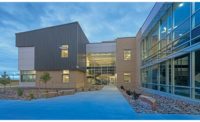From his office window, Meckes can see crews drilling shafts in preparation for pilings. He says work is proceeding briskly in order to complete the span— dubbed Park Over the Highway—by December, with future phases of the project due for a 2015 completion to mark the Arch's 50th anniversary.
"If the I-70 interchange was about saving money, Park Over the Highway is about saving time," adds Law. Design work, he says, was accelerated by three months as soon as contract negotiations commenced. A one-day construction staging workshop yielded no fewer than 14 design initiatives to shave the project's schedule by four months.
Logistics are convoluted, and call for demolition of a pair of bridges to make way for Park Over the Highway as well as relocation of attendant systems, including a steam line feeding the Arch. Elsewhere, deck and base of a third bridge slated for demolition are serving as staging areas for construction of end bents for the landscaped bridge.
Although CMT envisioned a box-like structure for the bridge, it later incorporated catenary curves at two ends in order to mimic the lines of the Arch—a configuration that introduced trapezoidal geometries to the structure. The finished design calls for straight girders for central portions of the bridge and splayed members closer to the catenary walls. Complex loading studies accounted for myriad variables, including paving, sidewalks and trees.
CMT employees believe firmly in quality but also equality. For Park Over the Highway, as with other of its projects, participation rates among disadvantaged business enterprises (DBE) exceed project requirements. MoDOT set a goal of 20%. CMT hit 32%. Of 10 subconsultants for the I-70 interchange, seven of the participants were DBE firms.
"A more diverse project team is a more innovative project team," says Meckes. "Everyone brings something to the table that's unique to their experience. For I-70, CMT engaged subconsultants in informal mentoring to acclimate them to a project of its magnitude.
DBE requirements for client Lambert-St. Louis International Airport vary, depending on how projects are funded. "In one instance, we'd assembled a team to meet the 30% goal at Lambert, then kept the same percentage—and team—intact when we bid on a federally funded project requiring only 10% DBE participation," says Meckes. "Ultimately, it's about relationships that develop over time."
Mentoring programs continue. "We have our CFO engage with firms and our marketing team engage with them," says Meckes. "We've also given them our project management manuals and told them to run with it."
CMT, meantime, is charting its own path for growth. Although acquisitions have bolstered its presence in Indianapolis; Springfield, Mo.; and Edwardsville, Ill., growth in other offices, including those in Chicago and Aurora, Ill., has largely been organic.







